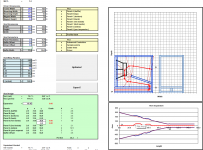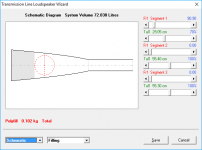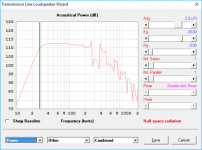This thread is for any and all design ideas for a mass loaded transmission line ml-tl subwoofer. While the ml-tl alignment is most often used for fullrange speakers or for the woofer section in a tower speaker, but im wanting to apply the design concept to a subwoofer in a 2.1 system.
The current subwoofer im running is a Dayton Audio DCS305-4 12" Classic Subwoofer 4 Ohm
Thiele-Small Parameters
(Fs)24.2 Hz
(Re)3.3 ohms
(Le)2.06 mH
(Qms)5.07
(Qes)0.43
(Qts)0.40
(Vas)3.25 ft.³
(Cms)0.27 mm/N
(BL)13.7 Tm
(Mms)160g
(Xmax)9.3 mm
(Sd)498.8 cm²
Ive had a hard time finding anyone publishing anything about useing this alignment in a subwoofer application, but the few rules of thumb ive found and that ive prescribed to my initial design are as fallows,
1. Non taper line legnth can be ~60% of a traditional TL line length.
2. Port tune to the box vb.
3. Speaker offset from the closed end 1/3, 1/5, depending on the desired harmonic to suppress, if any offset at all, max gain with no offset but a sharp dip at the first harmonic.
This is very general information ive gleamed from the google box. True or untrue it was my starting point for this design.
I used the golden ratio of phi (.61803) for the line length, my initial design goal was to incorporate phi into as many dimensions as possible.
Line lenghth calculations
(Based on ~60%(Usning phi .61803))
1130/24.2=46.7
/4=11.67ft
*12=140.08" Line length
*.61803=86.58" Phi Line Length
*.60=84" 60% Line Length
Resulting in 3.93ft3 internal Gross Volume via the layouts ive attached.
Ive also proposed a cut away of extra space where the ports inter into the line to maintain the sd cross section.
Ive also proposed two 3"dia. ports because that is the current stock of tubing i have available, extra thick with an outside dia. of 3.75". This sub will be played a maximum volume often, and my current enclosure cuff's quite a bit a max volume.
Any and all advice would greatly be appreciated and any debate is welcome. I need help with any simulations (speaker offsets) and proposed design adjustments. Also port length which ultimately would hinge on any design changes.
The current subwoofer im running is a Dayton Audio DCS305-4 12" Classic Subwoofer 4 Ohm
Thiele-Small Parameters
(Fs)24.2 Hz
(Re)3.3 ohms
(Le)2.06 mH
(Qms)5.07
(Qes)0.43
(Qts)0.40
(Vas)3.25 ft.³
(Cms)0.27 mm/N
(BL)13.7 Tm
(Mms)160g
(Xmax)9.3 mm
(Sd)498.8 cm²
Ive had a hard time finding anyone publishing anything about useing this alignment in a subwoofer application, but the few rules of thumb ive found and that ive prescribed to my initial design are as fallows,
1. Non taper line legnth can be ~60% of a traditional TL line length.
2. Port tune to the box vb.
3. Speaker offset from the closed end 1/3, 1/5, depending on the desired harmonic to suppress, if any offset at all, max gain with no offset but a sharp dip at the first harmonic.
This is very general information ive gleamed from the google box. True or untrue it was my starting point for this design.
I used the golden ratio of phi (.61803) for the line length, my initial design goal was to incorporate phi into as many dimensions as possible.
Line lenghth calculations
(Based on ~60%(Usning phi .61803))
1130/24.2=46.7
/4=11.67ft
*12=140.08" Line length
*.61803=86.58" Phi Line Length
*.60=84" 60% Line Length
Resulting in 3.93ft3 internal Gross Volume via the layouts ive attached.
Ive also proposed a cut away of extra space where the ports inter into the line to maintain the sd cross section.
Ive also proposed two 3"dia. ports because that is the current stock of tubing i have available, extra thick with an outside dia. of 3.75". This sub will be played a maximum volume often, and my current enclosure cuff's quite a bit a max volume.
Any and all advice would greatly be appreciated and any debate is welcome. I need help with any simulations (speaker offsets) and proposed design adjustments. Also port length which ultimately would hinge on any design changes.
Attachments
Very valid question Sonce, for me its the challenge, sort of a mental work out in designing it, that will hopefully lead to a better understanding of how sound is reproduced and how i perceive it. Ive built several vented enclosures for subs and towers and am looking to advance their capabilities, even if its a marginal amount. Ive built several transmission lines for full range speakers, and most recently have built the Mini Karlsonator (0.4x Scale) via this https://www.diyaudio.com/forums/full-range/239338-mini-karlsonator-0-53x-dual-tc9fds-16.html#post3722988. It uses a very inexpensive 3.5" speaker and the mid bass is unreal, everything about the speaker defies convention and that really is what has led me down the mass loaded rabbit hole.
I realize you can get a pretty low f3 with just a standard vented enclosure, but i would like to push the limit of this speakers low end, beyond even its listed specs. While also incorporating the benefits of quarter wave loading. Hopefully to mitigate cone movement in the pass band where it would be pushed beyond xmax at less than full power, ~35hz range according to Winisd for a comparable sized vented box tuned in the low 20hz range, the 35hz range is right around the 60% mark of the quarter wave length of this presented design. Using the line length at a higher tuning and ports at a lower tuning, hopefully will help load the cone over a larger pass band.
I love all genres of music, not so much pop music, but the fundamentals that make up pop music i can appreciate and am often hooked by, and i realize that alot of music has nothing to do with the sub 20hz~30hz range, but ive always been drawn to the tactile and visceral effects of bass centric music. I lovvvvve electronic music and its many sub-genres of face melting bass. There are genres that focus on the lowest octave of human hearing, where the root note of the bass line is in the mid to upper 20hz range. An artist named Decaf has pioneered and became so popular in the "screwed and e'qued" genre that his name is now used as an adverb for the genre, ie Decaf'ed, some if not most of the genre is cliche but there are many artistic attempts at pushing the the sonic boundarys with music. I also love classical music, just as a parent would love all their children equally lol, and the pipe organ is the instrument of the original bass head, attached below is the cover and program notes of a used record that i was sold on at first sight, i knew i had to buy it as soon a saw it in the bin. For one its a direct to disc master cutting and the producers were brutally honest account of its recording. At the very bottom it talks about the sonic limits of the organ and recording space, the main pipes are 36' tall and are tuned to 16hz. The building was built just for this organ, its not a church or a tabernacle, its just for the organ and its listening, and in that vein i find my self dedicated to the pursuit of maximizing thee lowest frequencies of this subwoofer enclosures design.
I guess to sum up why, i would say its fun, to design and push limits.
I realize you can get a pretty low f3 with just a standard vented enclosure, but i would like to push the limit of this speakers low end, beyond even its listed specs. While also incorporating the benefits of quarter wave loading. Hopefully to mitigate cone movement in the pass band where it would be pushed beyond xmax at less than full power, ~35hz range according to Winisd for a comparable sized vented box tuned in the low 20hz range, the 35hz range is right around the 60% mark of the quarter wave length of this presented design. Using the line length at a higher tuning and ports at a lower tuning, hopefully will help load the cone over a larger pass band.
I love all genres of music, not so much pop music, but the fundamentals that make up pop music i can appreciate and am often hooked by, and i realize that alot of music has nothing to do with the sub 20hz~30hz range, but ive always been drawn to the tactile and visceral effects of bass centric music. I lovvvvve electronic music and its many sub-genres of face melting bass. There are genres that focus on the lowest octave of human hearing, where the root note of the bass line is in the mid to upper 20hz range. An artist named Decaf has pioneered and became so popular in the "screwed and e'qued" genre that his name is now used as an adverb for the genre, ie Decaf'ed, some if not most of the genre is cliche but there are many artistic attempts at pushing the the sonic boundarys with music. I also love classical music, just as a parent would love all their children equally lol, and the pipe organ is the instrument of the original bass head, attached below is the cover and program notes of a used record that i was sold on at first sight, i knew i had to buy it as soon a saw it in the bin. For one its a direct to disc master cutting and the producers were brutally honest account of its recording. At the very bottom it talks about the sonic limits of the organ and recording space, the main pipes are 36' tall and are tuned to 16hz. The building was built just for this organ, its not a church or a tabernacle, its just for the organ and its listening, and in that vein i find my self dedicated to the pursuit of maximizing thee lowest frequencies of this subwoofer enclosures design.
I guess to sum up why, i would say its fun, to design and push limits.
Attachments
My first thought is that this driver should not be used in a mass loaded TL because with a relatively low 0.4 Qts, the motor is strong enough to be used in a plain tapered TL. This will have significantly higher bass efficiency as the vent area will be many times greater than the two round ducts to allow an ease of air flow fr the back side of the cone. A MLTL is really meant for a moderate to higher Qts driver of circa 0.5 to 0.7 to allow the tuning of the bottom bass corner frequency to be below that of the natural box length frequency. In this case, the length is quite long at 140in and Qts is low at 0.4. 140in is a 24Hz natural 1/4wave frequency. No need to mass load as it matches the fs already. I would do a 4:1 taper and make total volume equal to Vas and set baffle width at about 2in wider than bezel. Offset driver by 20% to 33% from sealed end.
So 3.2 cu ft is 14in W x 18in deep x 22in H. Try to get at least a 40Hz tuning or 84in long. That’s about 4 folds along 22in. Go folding scheme like this: 8in x 5in x 3in x 2in vent.
Then mount driver at first fold or 20% from closed end. I would fold vent around to front if you want to add another 18in or vent out the back or top. This will give 33Hz tuning. Perfect for 24Hz fs with 0.4 Qts.
Try sketching that.
So 3.2 cu ft is 14in W x 18in deep x 22in H. Try to get at least a 40Hz tuning or 84in long. That’s about 4 folds along 22in. Go folding scheme like this: 8in x 5in x 3in x 2in vent.
Then mount driver at first fold or 20% from closed end. I would fold vent around to front if you want to add another 18in or vent out the back or top. This will give 33Hz tuning. Perfect for 24Hz fs with 0.4 Qts.
Try sketching that.
An MLTL can be folded like this, just saying...
The Subwoofer DIY Page v1.1 - Projects : The Boom Unit
The Subwoofer DIY Page v1.1 - Projects : The Boom Unit
Nice low resonance. Roughly like my driver in the first link bellow. Think in terms of keeping that resonance where it is rather than boxing it upwards. TL's traffic in resonances, not much different than BR's. A long well-damped pipe doesn't. It just takes the back wave and handles it otherwise.
Nice recording but his Ruffatti organ in Davies Hall with roughly the same pieces is better.
17 foot pipe sub 12-230 Hz ±5dB - diyAudio
Long pipe to sequester rear wave - diyAudio
B.
Nice recording but his Ruffatti organ in Davies Hall with roughly the same pieces is better.
17 foot pipe sub 12-230 Hz ±5dB - diyAudio
Long pipe to sequester rear wave - diyAudio
B.
Last edited:
An MLTL can be folded like this, just saying...
The Subwoofer DIY Page v1.1 - Projects : The Boom Unit
I totally stole your spreadsheet to do a mltl sub design. Great resource and some folds are just as easy as internal bracing so why not?
OP: there's not a huge difference to a vented sub, so use Brian's sheet and play with hornresp. See what ends up working!
After playing with my workbook for awhile, I was able to come up with a similar MLTL to my "Boom Unit", one that would fit the DCS305, given the published parameters. This should be considered a preliminary design, and some fine-tuning will be required, but it does look promising.
Attachments
- Status
- This old topic is closed. If you want to reopen this topic, contact a moderator using the "Report Post" button.
- Home
- Loudspeakers
- Subwoofers
- ML-TL Subwoofer Design Concept
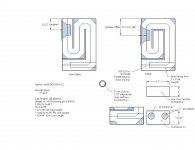
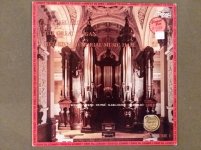
![20181013_212911[1].jpg](/community/data/attachments/647/647002-4de3b678c174d548b4c4834e4a139d0c.jpg)
